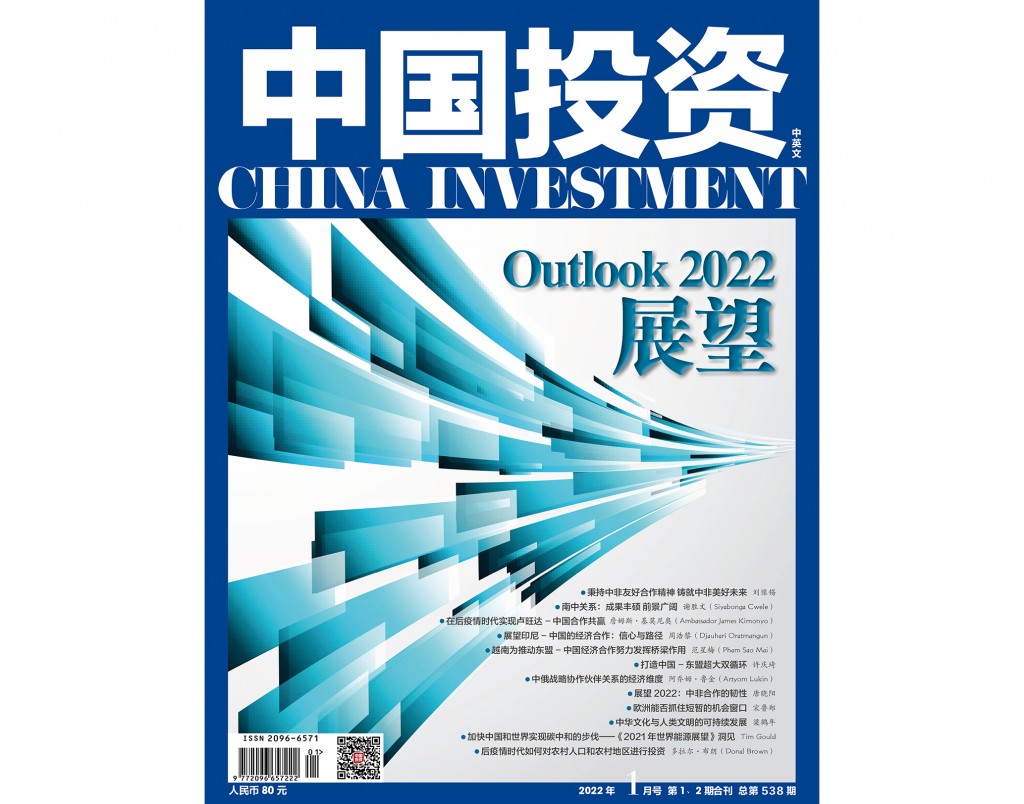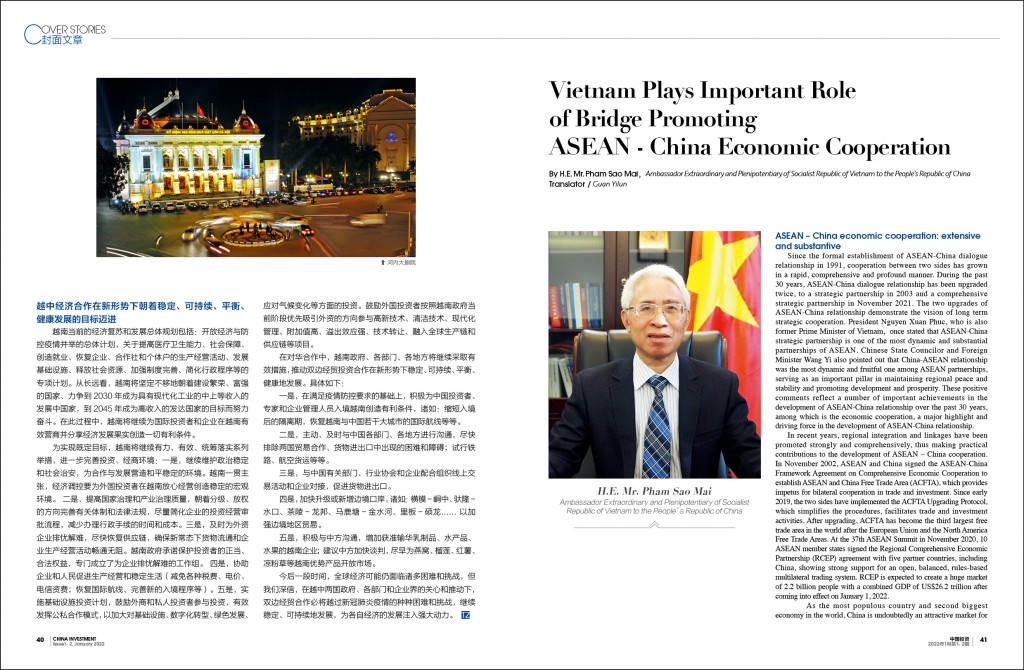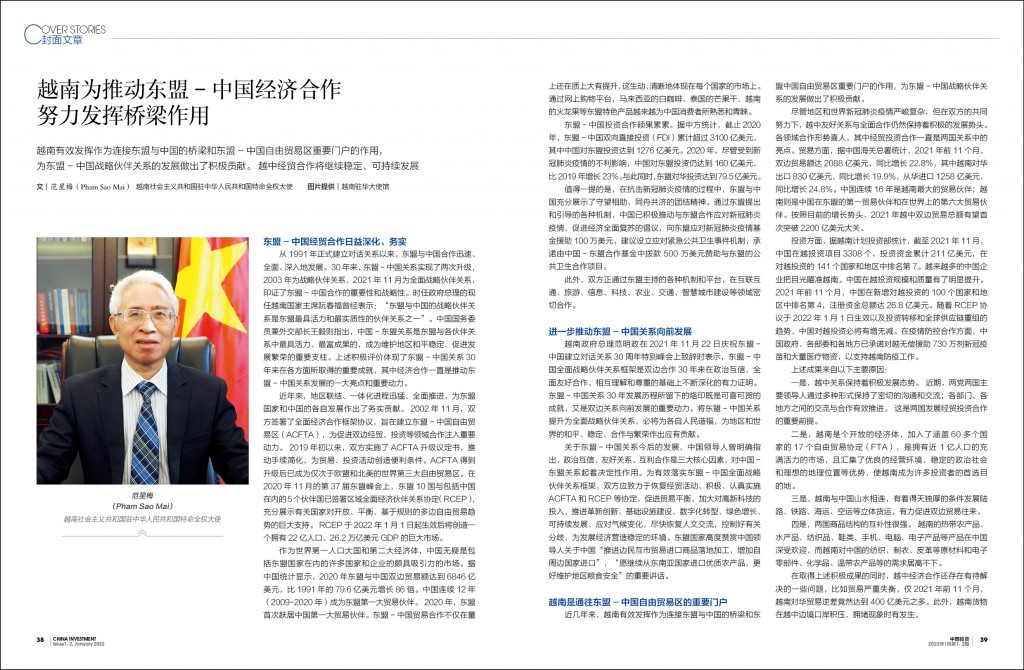
2022展望
By H.E. Mr. Pham Sao Mai,Ambassador Extraordinary and Plenipotentiary of Socialist Republic of Vietnam to the People’s Republic of China
文|范星梅(Pham Sao Mai) 越南社会主义共和国驻中华人民共和国特命全权大使
导读
●东盟-中国经贸合作日益深化、务实
●进一步推动东盟-中国关系向前发展
●越南是通往东盟-中国自由贸易区的重要门户
●越中经济合作在新形势下朝着稳定、可持续、平衡、健康发展的目标迈进
Vietnam Plays Important Role of Bridge Promoting ASEAN – China Economic Cooperation
ASEAN – China economic cooperation: extensive and substantive
Since the formal establishment of ASEAN-China dialogue relationship in 1991, cooperation between two sides has grown in a rapid, comprehensive and profound manner. During the past 30 years, ASEAN-China dialogue relationship has been upgraded twice, to a strategic partnership in 2003 and a comprehensive strategic partnership in November 2021. The two upgrades of ASEAN-China relationship demonstrate the vision of long term strategic cooperation. President Nguyen Xuan Phuc, who is also former Prime Minister of Vietnam, once stated that ASEAN-China strategic partnership is one of the most dynamic and substantial partnerships of ASEAN. Chinese State Councilor and Foreign Minister Wang Yi also pointed out that China-ASEAN relationship was the most dynamic and fruitful one among ASEAN partnerships, serving as an important pillar in maintaining regional peace and stability and promoting development and prosperity. These positive comments reflect a number of important achievements in the development of ASEAN-China relationship over the past 30 years, among which is the economic cooperation, a major highlight and driving force in the development of ASEAN-China relationship.
In recent years, regional integration and linkages have been promoted strongly and comprehensively, thus making practical contributions to the development of ASEAN – China cooperation. In November 2002, ASEAN and China signed the ASEAN-China Framework Agreement on Comprehensive Economic Cooperation to establish ASEAN and China Free Trade Area (ACFTA), which provides impetus for bilateral cooperation in trade and investment. Since early 2019, the two sides have implemented the ACFTA Upgrading Protocol, which simplifies the procedures, facilitates trade and investment activities. After upgrading, ACFTA has become the third largest free trade area in the world after the European Union and the North America Free Trade Areas. At the 37th ASEAN Summit in November 2020, 10 ASEAN member states signed the Regional Comprehensive Economic Partnership (RCEP) agreement with five partner countries, including China, showing strong support for an open, balanced, rules-based multilateral trading system. RCEP is expected to create a huge market of 2.2 billion people with a combined GDP of US$26.2 trillion after coming into effect on January 1, 2022.
As the most populous country and second biggest economy in the world, China is undoubtedly an attractive market for many countries, including ASEAN countries. According to Chinese statistics, the bilateral trade between ASEAN and China reached US$684.6 billion in 2020, skyrocketed by 86 times in three decades. China has been ASEAN’s top trading partner for 12 consecutive years (from 2009 to 2020) while in 2020, ASEAN became China’s largest trading partner for the first time Trade between ASEAN and China has seen progress not only in quantity but also in quality, which is vividly and clearly reflected in every ASEAN country’s market. Through online shopping platforms, Chinese consumers are now more and more familiar with and inclined to ASEAN specialties such as white coffee from Malaysia, dried mangoes from Thailand and dragon fruit from Vietnam.
ASEAN – China cooperation also witnessed positive developments in term of investment. According to Chinese statistics, by 2020, the two-way foreign direct investment (FDI) has accumulated to more than US$310 billion, with Chinese investment in ASEAN reaching US$127.6 billion. Despite the impact of the COVID-19 pandemic, China’s investment in ASEAN reached US$16 billion in 2020, with a 23% increase from 2019. Meanwhile, ASEAN investment in China reached US$7.95 billion.
It is worth noting that ASEAN and China have fully demonstrated their willingness to cooperation and mutual support in the fight against the pandemic. Through various mechanisms proposed and led by ASEAN, China has actively promoted the initiative to jointly contain the pandemic and pursue full economic recovery, and has donated US$1 million to the ASEAN COVID-19 Response Fund. China also suggested to establish mechanisms to respond to public health emergencies, and committed to allocate US$5 million from China-ASEAN Cooperation Fund to sponsor the public health cooperation projects with ASEAN.
Besides, the two sides are working closely together in the areas of connectivity, tourism, information, science and technology, agriculture, transportation, and Smart City building through various mechanisms and platforms hosted by ASEAN.
Addressing at the ASEAN-China Special Summit to Commemorate the 30th anniversary of ASEAN-China dialogue relations on November 22, 2021, Vietnamese Prime Minister Pham Minh Chinh affirmed that the ASEAN-China comprehensive strategic partnership framework is indicative of the outcomes of cooperation between the two sides over the last 30 years based on political trust, friendship, comprehensive cooperation, mutual understanding and mutual respect. The past achievements are exemplary for both sides to advance the relationship in line with comprehensive strategic partnership framework, for the peace, stability, cooperation and prosperity of the region and the world.
Chinese leader has clearly pointed out three centerpieces that play a decisive role in the future development of China-ASEAN relationship, are political mutual trust, friendly relations and mutually beneficial cooperation. In order to effectively implement the framework of ASEAN-China comprehensive strategic partnership, both sides should work to resume trade, implement agreements such as ACFTA and RCEP actively and earnestly, promote trade balance, and to increase investment in high technology. Both sides need to promote innovation, infrastructure construction, digital transformation, green growth, sustainable development, and climate change regulations. It is also advisable to resume cultural and people-to-people communication, tackle differences in a proper way and to create a stable environment for economic development as soon as possible. The ASEAN countries highly appreciate the remark of Chinese leaders, stressing that China will “encourage the on-site processing of imported goods from trading between border residents, and increase imports from neighboring countries”, “continue to import high-quality agricultural products from Southeast Asian countries in order to diversify supply chains, to better maintain regional food security and sustainable agriculture development”.
In recent years, Vietnam has effectively served as a bridge connecting ASEAN and China and an important gateway to the ASEAN-China Free Trade Area, contributing to the ASEAN-China strategic partnership.
Despite the complicated situation with the pandemic in both the region and the world, Vietnam-China friendly relations and comprehensive cooperation have maintained the momentum thanks to joint effort of both sides. Among the promising cooperation in various fields between Vietnam and China, trade and investment have been the spotlight. According to General Administration of Customs of China, in the first 11 months of 2021, total bilateral trade reached US$208.8 billion, with a year-on-year increase of 22.8%. More specifically, Vietnam’s exports to China amounted to US$83 billion, with a year-on-year increase of 19.9%, and imports from China amounted to US$125.8 billion, with a year-on-year increase of 24.8%. China has been Vietnam’s largest trading partner for 16 years, with Vietnam being China’s largest trading partner in ASEAN and the sixth largest trading partner in the world. As bilateral trade continues to grow, it’s expected that trade volume between Vietnam and China is to exceed US$220 billion for the first time in 2021.
In terms of investment, according to the Ministry of Planning and Investment of Vietnam, China has invested 3,308 projects in Vietnam with a total investment capital of US$21.1 billion by November 2021, ranking 7th among 141 countries and territories which have invested in Vietnam. Now, more and more Chinese enterprises are setting their eyes on Vietnam and there is an obvious increase in the scale and quality of Chinese investment in Vietnam. In the first 11 months of 2021, China ranked No. 4 among 100 countries and territories which have increased investment in Vietnam, with total registered capital of US$2.68 billion. With the RCEP agreement coming into effect on January 1, 2022 and the trend of investment diversion and global supply chain restructuring, Chinese investment in Vietnam is bound to increase. In terms of cooperation in the pandemic prevention and control, the central government, ministries and local governments of China have promised to provide 7.3 million doses of COVID-19 vaccine and a large number of medical supplies free of charge to support Vietnam’s prevention of the pandemic.
Reasons for the above achievements are as follows.
First, Vietnam and China have always maintained close and positive cooperation. Leaders of the Communist Party of China and the Communist Party of Vietnam have maintained close communication and exchanges through various channels; cooperation between different sectors and local governments of the two countries has been effectively bolstered. This is an important prerequisite for developing the cooperation of trade and investment between the two countries.
Second, Vietnam is an open economy, with 17 Free Trade Agreements (FTAs) that have covered more than 60 countries have been signed. It also has a dynamic market with a population of nearly 100 million, and enjoys strengths of an excellent business environment, a stable political society and an ideal geographical location, making Vietnam a prime destination for many investors.
Third, Vietnam and China share a long land border line, creating favorable conditions for the two countries to develop comprehensive freight transport by land, rail, sea and air, facilitate the bilateral trade between Vietnam and China.
Fourth, the commodity structure of the two countries is highly complementary. Vietnam exports to China tropical agricultural products, aquatic products, textiles, footwear, phones, computers, and electronic products and imports from China raw materials for textiles, garments, leather, shoes, electronic products, components, fabrics, chemicals, temperate agricultural products…
Despite the above positive results, economic cooperation between the two countries still has some shortcomings and limitations that need to be overcome such as unbalanced trade. In the first 11 months of 2021, Vietnam’s trade deficit with China surpassed US$40 billion. In addition, import and export activities through border gates were congested during harvest season.
Vietnam has currently schematized its economic recovery and development by an overall plan of opening up the economy and preventing and controlling the pandemic. It has also issued special plans of improving healthcare capacity and social security, creating jobs, restoring production and business activities of enterprises, cooperatives and self-employed individuals, developing infrastructure, releasing social resources, enhancing institutional systems, and simplifying administrative procedures. In the long term, Vietnam will be dedicated to building a prosperous and strong country, an upper middle-income developing country with modern industries by 2030 and a high-income developed country by 2045. In this process, Vietnam will continue to create all the favourable conditions that international investors and enterprises need to do business effectively in Vietnam and to share the fruits of Vietnamese economic development.
To achieve the goals, Vietnam will continue to implement a series of initiatives in a strong, effective and integrated manner to further improve the investment and business environment.
First, continue to maintain political stability and social security to create a peaceful and stable environment for cooperation and development. Vietnam consistently advocates that economic regulations should create a stable macro environment for foreign investors to operate in Vietnam.
Second, strengthen national and sector governance. Vietnam will improve the relevant institutions and laws and regulations in the direction of gradual decentralization at different government levels, simplify the approval process of investment and operation for enterprises as much as possible, and reduce the time and cost for the administrative procedures.
Third, promptly address foreign businesses’ concerns in order to restore the supply chain, ensure the flow of goods and the production and business of enterprises in the post Covid-19 era. The Vietnamese government is committed to protecting the legitimate and lawful rights and interests of investors, and has set up a working group to solve the problems of enterprises.
Fourth, assist the enterprises and the people to promote the production and operation as well as the stability of daily life (including reducing and waiving various taxes, fees, electricity and telecommunications tariffs, resuming international air routes, and improving new immigration procedures).
Fifth, implement the infrastructure investment plan, encourage foreign and private investors to participate in any forms of investment, particularly the Public-Private Partnership model in the field of infrastructure, digital transformation, green development, climate change. Foreign investors are encouraged to participate in projects of new, clean and high technology, modern management with high-added value and strong spillover effects, technology transfer, global manufacturing and supply chains linkages in line with the current attracting foreign investment policy of Vietnam.
In the cooperation with China, the central government, ministries and local governments in Vietnam will continue to take effective measures to promote the stable, sustainable, balanced and healthy development of trade and investment in the new situation. Details are as follows.
First, while underscoring the pandemic prevention and control regulations, Vietnam will adopt favorable measures for Chinese investors, experts and business managers to enter Vietnam, such as shortening the quarantine period, resuming international air routes between Vietnam and several major cities in China.
Second, Vietnam will communicate with Chinese ministries and local governments actively and timely, remove the difficulties and obstacles in the trade cooperation and importation and exportation between the two countries as soon as possible, jointly piloting freight transportation by rail and by sea, etc.
Third, work with relevant Chinese departments, industry associations and enterprises to co-organize virtual trade promotion activities to link the two countries businesses and to boost two-way trade.
Fourth, in order to promote the border trading, both sides need to speed up the process of upgrading or opening of land border gates, including Hoanh Mo – Dongzhong, Ta Lung -Shuikou, Tra Linh – Longbang, Ma Lu Thang – Jinshui River, Ly Van – Shuolong.
Fifth, Vietnam will work closely with the Chinese side to expand the number of Vietnamese businesses that are eligible to export dairy products, aquatic products and fruits to China. Besides, it is suggested that China accelerate the negotiation to open up the market for Vietnam’s key export items such as bird’s nest, durian, sweet potatoes and Mesona Chinensis Benth.
The global economy may still face many difficulties and challenges for a certain time. However, with the support of the governments, ministries and business communities of the two countries, bilateral economic and trade cooperation is sure to overcome all the difficulties and challenges of the pandemic and to continue growing steadily and sustainably, providing a strong impetus to the economies of both countries./.
东盟-中国经贸合作日益深化、务实
从1991年正式建立对话关系以来,东盟与中国合作迅速、全面、深入地发展。 30年来,东盟-中国关系实现了两次升级,2003年为战略伙伴关系,2021年11月为全面战略伙伴关系,印证了东盟-中国合作的重要性和战略性。时任政府总理的现任越南国家主席阮春福曾经表示:“东盟与中国的战略伙伴关系是东盟最具活力和最实质性的伙伴关系之一”。中国国务委员兼外交部长王毅则指出,中国-东盟关系是东盟与各伙伴关系中最具活力、最富成果的,成为维护地区和平稳定、促进发展繁荣的重要支柱。上述积极评价体现了东盟-中国关系30年来在各方面所取得的重要成就,其中经济合作一直是推动东盟-中国关系发展的一大亮点和重要动力。
近年来,地区联结、一体化进程迅猛、全面推进,为东盟国家和中国的各自发展作出了务实贡献。 2002年11月,双方签署了全面经济合作框架协议,旨在建立东盟-中国自由贸易区(ACFTA),为促进双边经贸、投资等领域合作注入重要动力。 2019年初以来,双方实施了ACFTA升级议定书,推动手续简化,为贸易、投资活动创造便利条件。ACFTA得到升级后已成为仅次于欧盟和北美的世界第三大自由贸易区。在2020年11月的第37届东盟峰会上,东盟10国与包括中国在内的5个伙伴国已签署区域全面经济伙伴关系协定(RCEP),充分展示有关国家对开放、平衡、基于规则的多边自由贸易趋势的巨大支持。 RCEP于2022年1月1日起生效后将创造一个拥有22亿人口、26.2万亿美元GDP的巨大市场。
作为世界第一人口大国和第二大经济体,中国无疑是包括东盟国家在内的许多国家和企业的颇具吸引力的市场。据中国统计显示,2020年东盟与中国双边贸易额达到6846亿美元,比1991年的79.6亿美元增长86倍。中国连续12年(2009-2020年)成为东盟第一大贸易伙伴。 2020年,东盟首次跃居中国第一大贸易伙伴。东盟-中国贸易合作不仅在量上还在质上大有提升,这生动、清晰地体现在每个国家的市场上。通过网上购物平台,马来西亚的白咖啡、泰国的芒果干、越南的火龙果等东盟特色产品越来越为中国消费者所熟悉和青睐。
东盟-中国投资合作硕果累累。据中方统计,截止2020年,东盟-中国双向直接投资(FDI)累计超过3100亿美元,其中中国对东盟投资达到1276亿美元。2020年,尽管受到新冠肺炎疫情的不利影响,中国对东盟投资仍达到160亿美元,比 2019 年增长 23%。与此同时,东盟对华投资达到79.5亿美元。
值得一提的是,在抗击新冠肺炎疫情的过程中,东盟与中国充分展示了守望相助、同舟共济的团结精神。通过东盟提出和引导的各种机制,中国已积极推动与东盟合作应对新冠肺炎疫情、促进经济全面复苏的倡议,向东盟应对新冠肺炎疫情基金援助100万美元,建议设立应对紧急公共卫生事件机制,承诺由中国-东盟合作基金中拨款 500 万美元赞助与东盟的公共卫生合作项目。
此外,双方正通过东盟主持的各种机制和平台,在互联互通、旅游、信息、科技、农业、交通、智慧城市建设等领域密切合作。
⬆ 河内大剧院
进一步推动东盟-中国关系向前发展
越南政府总理范明政在2021年11月22日庆祝东盟-中国建立对话关系30周年特别峰会上致辞时表示,东盟-中国全面战略伙伴关系框架是双边合作30年来在政治互信、全面友好合作、相互理解和尊重的基础上不断深化的有力证明。东盟-中国关系30年发展历程所留下的烙印既是可喜可贺的成就,又是双边关系向前发展的重要动力。将东盟-中国关系提升为全面战略伙伴关系,必将为各自人民造福,为地区和世界的和平、稳定、合作与繁荣作出应有贡献。
关于东盟-中国关系今后的发展,中国领导人曾明确指出,政治互信、友好关系、互利合作是三大核心因素,对中国-东盟关系起着决定性作用。为有效落实东盟-中国全面战略伙伴关系框架,双方应致力于恢复经贸活动,积极、认真实施ACFTA和RCEP等协定,促进贸易平衡,加大对高新科技的投入,推进革新创新、基础设施建设、数字化转型、绿色增长、可持续发展、应对气候变化,尽快恢复人文交流,控制好有关分歧,为发展经济营造稳定的环境。东盟国家高度赞赏中国领导人关于中国“推进边民互市贸易进口商品落地加工,增加自周边国家进口”,“愿继续从东南亚国家进口优质农产品,更好维护地区粮食安全”的重要讲话。
越南是通往东盟-中国自由贸易区的重要门户
近几年来,越南有效发挥作为连接东盟与中国的桥梁和东盟中国自由贸易区重要门户的作用,为东盟-中国战略伙伴关系的发展做出了积极贡献。
尽管地区和世界新冠肺炎疫情严峻复杂,但在双方的共同努力下,越中友好关系与全面合作仍然保持着积极的发展势头。各领域合作形势喜人,其中经贸投资合作一直是两国关系中的亮点。贸易方面,据中国海关总署统计,2021年前11个月,双边贸易额达2088亿美元,同比增长22.8%,其中越南对华出口830亿美元,同比增长19.9%,从华进口1258亿美元,同比增长24.8%。中国连续16年是越南最大的贸易伙伴;越南则是中国在东盟的第一贸易伙伴和在世界上的第六大贸易伙伴。按照目前的增长势头,2021年越中双边贸易总额有望首次突破2200亿美元大关。
投资方面,据越南计划投资部统计,截至2021年11月,中国在越投资项目3308个,投资资金累计211亿美元,在对越投资的141个国家和地区中排名第7。越来越多的中国企业把目光瞄准越南。中国在越投资规模和质量有了明显提升。 2021年前11个月,中国在新增对越投资的100个国家和地区中排名第4,注册资金总额达26.8亿美元。随着RCEP协议于2022年1月1日生效以及投资转移和全球供应链重组的趋势,中国对越投资必将有增无减。在疫情防控合作方面,中国政府、各部委和各地方已承诺对越无偿援助730万剂新冠疫苗和大量医疗物资,以支持越南防疫工作。
上述成果来自以下主要原因:
一是,越中关系保持着积极发展态势。 近期,两党两国主要领导人通过多种形式保持了密切的沟通和交流;各部门、各地方之间的交流与合作有效推进。 这是两国发展经贸投资合作的重要前提。
二是,越南是个开放的经济体,加入了涵盖60多个国家的17个自由贸易协定(FTA),是拥有近 1亿人口的充满活力的市场,且汇集了优良的经营环境、稳定的政治社会和理想的地理位置等优势,使越南成为许多投资者的首选目的地。
三是,越南与中国山水相连,有着得天独厚的条件发展陆路、铁路、海运、空运等立体货运,有力促进双边贸易往来。
四是,两国商品结构的互补性很强。 越南的热带农产品、水产品、纺织品、鞋类、手机、电脑、电子产品等产品在中国深受欢迎,而越南对中国的纺织、制衣、皮革等原材料和电子零部件、化学品、温带农产品等的需求居高不下。
在取得上述积极成果的同时,越中经济合作还存在有待解决的一些问题,比如贸易严重失衡,仅2021年前11个月,越南对华贸易逆差竟然达到400亿美元之多。此外,越南货物在越中边境口岸积压、拥堵现象时有发生。
越中经济合作在新形势下朝着稳定、可持续、平衡、健康发展的目标迈进
越南当前的经济复苏和发展总体规划包括:开放经济与防控疫情并举的总体计划,关于提高医疗卫生能力、社会保障、创造就业、恢复企业、合作社和个体户的生产经营活动、发展基础设施、释放社会资源、加强制度完善、简化行政程序等的专项计划。从长远看,越南将坚定不移地朝着建设繁荣、富强的国家、力争到2030年成为具有现代化工业的中上等收入的发展中国家,到2045年成为高收入的发达国家的目标而努力奋斗。在此过程中,越南将继续为国际投资者和企业在越南有效营商并分享经济发展果实创造一切有利条件。
为实现既定目标,越南将继续有力、有效、统筹落实系列举措,进一步完善投资、经商环境:一是,继续维护政治稳定和社会治安,为合作与发展营造和平稳定的环境。越南一贯主张,经济调控要为外国投资者在越南放心经营创造稳定的宏观环境。 二是,提高国家治理和产业治理质量,朝着分级、放权的方向完善有关体制和法律法规,尽量简化企业的投资经营审批流程,减少办理行政手续的时间和成本。三是,及时为外资企业排忧解难,尽快恢复供应链,确保新常态下货物流通和企业生产经营活动畅通无阻。越南政府承诺保护投资者的正当、合法权益,专门成立了为企业排忧解难的工作组。 四是,协助企业和人民促进生产经营和稳定生活(减免各种税费、电价、电信资费;恢复国际航线、完善新的入境程序等)。五是,实施基础设施投资计划,鼓励外商和私人投资者参与投资,有效发挥公私合作模式,以加大对基础设施、数字化转型、绿色发展、应对气候变化等方面的投资。鼓励外国投资者按照越南政府当前阶段优先吸引外资的方向参与高新技术、清洁技术、现代化管理、附加值高、溢出效应强、技术转让、融入全球生产链和供应链等项目。
在对华合作中,越南政府、各部门、各地方将继续采取有效措施,推动双边经贸投资合作在新形势下稳定、可持续、平衡、健康地发展。具体如下:
一是,在满足疫情防控要求的基础上,积极为中国投资者、专家和企业管理人员入境越南创造有利条件,诸如:缩短入境后的隔离期,恢复越南与中国若干大城市的国际航线等等。
二是,主动、及时与中国各部门、各地方进行沟通,尽快排除两国贸易合作、货物进出口中出现的困难和障碍;试行铁路、航空货运等等。
三是,与中国有关部门、行业协会和企业配合组织线上交易活动和企业对接,促进货物进出口。
四是,加快升级或新增边境口岸,诸如:横模-峒中、驮隆-水口、茶陵-龙邦、马鹿塘-金水河、里板-硕龙…… 以加强边境地区贸易。
五是,积极与中方沟通,增加获准输华乳制品、水产品、水果的越南企业;建议中方加快谈判,尽早为燕窝、榴莲、红薯、凉粉草等越南优势产品开放市场。
今后一段时间,全球经济可能仍面临诸多困难和挑战,但我们深信,在越中两国政府、各部门和企业界的关心和推动下,双边经贸合作必将越过新冠肺炎疫情的种种困难和挑战,继续稳定、可持续地发展,为各自经济的发展注入强大动力。
编辑 | 伊 南
校对 | 闫建军
设计 | 大 米




